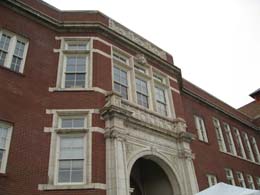On March 8, 2008, the Pacific Northwest African American Museum opens, welcoming an estimated 3,000 visitors. The museum, housed in Seattle's old Colman School building at 2300 S Massachusetts Street, celebrates its debut with a morning ribbon-cutting ceremony that includes Governor Christine Gregoire, U.S. Senator Maria Cantwell, U.S. Representative Jim McDermott, Seattle Mayor Greg Nickels (b. 1955), King County Executive Ron Sims, and King County Councilman Larry Gossett. The Rev. Samuel McKinney of the Mount Zion Baptist Church offers a prayer, and Executive Director Carver Gayton and Deputy Director Barbara Earl Thomas speak to the crowd about the long road from the museum's inception to its opening.
The Celebration
During a lull before the program began, Wyking Kwame Garrett, son of activist Omar Tahir-Garrett, took the microphone to protest the museum. The Garretts were among those who had fought for an African American museum by occupying the Coleman School for eight years. Garrett protested that the Northwest African American Museum was not what they had envisioned. Police arrested Garrett for suspicion of trespassing and obstruction after asking him to leave the ceremony.
Carver Gayton began his talk by saying in a pleasant tone, "Well that's one opinion." He went on to honor the hard work and sacrifice of those who had made the museum a reality, and asserted the need to secure the museum’s future. Barbara Earl Thomas spoke of how the museum represented the achievement of an entire community.
Mayor Greg Nickels spoke of Seattle’s pioneering African American residents such as Manuel Lopes and William Grose. Jim McDermott reflected on the wrongful prosecution of 43 black soldiers after a 1944 riot at Fort Lawton, an unjust conviction that was overturned in October 2007. Ron Sims recounted how important it had been to him as an African American youth to see the art of Jacob Lawrence on a trip to New York with his father. Those who had helped fund the project were honored, including Octavia Jackson, an 88-year-old supporter who received a lifetime membership to the museum.
The opening ceremonies included the presentation of two scholarships by the Dr. James Washington and Janie Rogella Washington Foundation. These Spirit in Stone scholarships were presented to artists Hugo Shi and Theresa James.
The Coming of the Museum
The Community Exchange, a multi-racial coalition, first proposed the idea of an African American museum to Mayor Charles Royer in 1981. In 1984, a task force of community members was formed to establish a museum, but a group of African American activists grew frustrated with the lack of progress and moved into the Colman School, a vacant elementary school in Seattle's Central Area neighborhood, in November 1985. The group, called the Citizens Support Committee for the African American Heritage Museum/Cultural Center, lived in the school building for eight years, making their occupation perhaps the longest act of civil disobedience in American history.
In 1993, the group left the Colman School when the city agreed to fund the museum. Still, debate and disagreement continued, and the museum project stalled. Finally, in 2003, the Urban League of Metropolitan Seattle purchased the Colman School from the Seattle School District for $800,000. The Urban League redesigned the school to accommodate the museum on the bottom floor and 36 units of affordable housing on the upper two floors. The project cost $22.6 million, including $8.1 million for museum construction.
The museum features 19,000 square feet of gallery space, an artists' workspace, office space, a genealogy research room, a gift shop, and a café. The gallery space includes the Journey Gallery, which relates the history of African Americans in the Northwest, and the Northwest Gallery, which at the museum's opening featured the works of artists Jacob Lawrence and James Washington Jr. The museum plans to use the Legacy Gallery as a place for meetings and for traveling exhibits.

